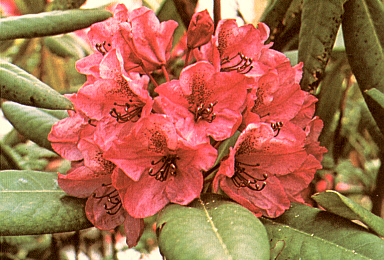QBARS - v26n4 Rhododendron macrophyllum Varies, Too!
Rhododendron macrophyllum Varies, Too!
Britt Smith, Kent, Wash.

|
|
R. macrophyllum
, a maroon form.
Photo by Britt Smith |
At approximately 3:30 in the afternoon on May 25, 1972, I answered the urgent ringing of the telephone on my desk at the office, and was greeted by "Hello, this is Bill Magness in Bandon, Oregon". This unusual greeting almost startled me and caused my mind to switch suddenly from an airplane design problem to the exciting prospect of some horticultural interest. Bill Magness went on to say that he had an extremely colorful R. macrophyllum blooming at his home and invited me to come there to see it.
Memorial Day was near at hand, so Dr. Frank Mossman and I had already planned one of our trips to "occidentale land" for that weekend and would drive through Bandon. My reply to Bill was that I would enjoy very much seeing the unusual flowers and would be there the following Monday.
Interest in unusual forms of R. macrophyllum was running high because an excellent white form of that species had been seen earlier in the month at Trillium Lane Nursery in Fort Bragg, California, a town which seems to be carved out of a thicket of R. macrophyllum . Marge and Bob Badger had accompanied Jean and me northward after the ARS Annual Meeting in San Francisco. We had visited Ft. Bragg as an interesting side trip along the way, before continuing on to Langlois, Oregon to see the deep, bright pink form of R. macrophyllum found there in 1971, and of course the early blooming forms of R. occidentale in the Crescent City area. At Langlois the deep pink R. macrophyllum was in full bloom and as colorful as reported in the October 1971 issue of the Quarterly Bulletin. Also the surrounding plants were in bloom, and we found several excellent variations. (Incidentally access to these plants is now denied because the land is posted "No Trespassing".) So these white, pink and deep pink variations had really prepared us for ready acceptance of Bill Magness' invitation.
On Monday, May 29, we arrived at Bill's home - this time "we" included Dr. and Mrs. Forrest Bump from Forest Grove, Oregon, John Disney from Tacoma, Washington, Dr. Frank Mossman, and 1. The rhododendron was at the best of its bloom and really attractively unusual. It is so deeply colored that it is almost maroon - considerably more deeply colored than the one which we had found the year before near Langlois. You can safely wager that each of us was very anxious to get propagations, and Bill generously offered cuttings which we took to the best propagator we know. Bill also took us for a walk through his natural garden where he has transplanted attractive variations of numerous species collected from the surrounding area. At one point he directed our attention to a R. macrophyllum plant which he had transplanted, and told us it had florets like large apple blossoms. Again cuttings were offered and accepted to accompany the others.
In August a letter arrived from Bill Magness. In it were color photographs of a seed capsule on his maroon flowered R. macrophyllum and, for comparison, a color photograph of a seed capsule on a normal R. macrophyllum . The pigmentation in the plant producing maroon colored flowers is so intense that the seed capsules are also maroon!
Unfortunately, the picture of the flowers does not present the color in the same intensity that it seemed when we saw them.
Persistent rumors tell of purple R. macrophyllum growing and blooming on the Olympic Peninsula in Washington. We would be very pleased to hear of any unusual variations of R. macrophyllum which would be attractive garden plants. Is there anyone who knows of purple R. macrophyllum and who is as interested and as willing to share as is Bill Magness? Evidence is accumulating rapidly - evidence that R. macrophyllum is as variable as we are convinced nearly every species of rhododendron is variable.
